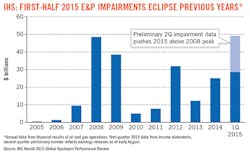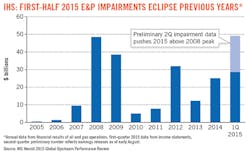An elevated level of asset impairments during the first two quarters, coupled with a bleak crude oil price outlook, has put 2015 on track to experience the highest exploration and production asset impairments in a decade.
The IHS Herold 2015 Global Upstream Performance Review concluded record impairments are likely to continue throughout Dec. 31 for US and Canadian E&P companies.
An asset impairment charge happens when an asset on a company's balance sheet is being carried at a higher value than the asset's current worth. Consequently, the company has to write off a portion of the asset's value.
First-quarter 2015 impairments for 66 exploration and production companies studied by IHS Herold totaled nearly $29 billion, exceeding the full-year 2014 total of slightly more than $25 billion and a 10-year annual average of more than $18 billion.
"Prolonged depressed prices for oil is hurting many of the E&Ps and will begin to limit their borrowing options," said Paul O'Donnell, principal equity analyst at IHS Energy and report author. "With proved reserves used as collateral for loans, E&Ps taking major write-downs in 2015 could have difficulty obtaining financing from their banks if prices remain depressed."
Companies also reported second-quarter impairments.
"Though early in the second quarter earnings cycle, we have already seen more than $20 billion in additional impairments reported by the group, which brings the year-to-date total to more than $49 billion and puts 2015 on track to blow the 2008 peak out of the water," O'Donnell said Aug. 5.
He forecast ceiling test prices would drop to about $53/bbl for oil and $2.80/MMcf of gas by Dec. 31.
The US Securities and Exchange Commission calculates proved reserves using the unweighted, trailing 12-month average of the closing prices from the first day of each month. Yearend 2014 impairment tests were evaluated using $94.99/bbl for oil and $4.31/MMcf for gas. These prices stemmed from robust prices during the first 10 months of 2014.
For first-quarter 2015, impairments were tested using $82.71/bbl and $3.88/MMcf-still elevated compared with market prices as of Aug. 5.
High DD&A poses a risk
Companies having a higher-cost capital base, identified as those with high depreciation, depletion and amortization expense, and assets outside core areas within the best plays were most at risk of significant impairment, the IHS report said.
Apache Corp., Devon Energy, and Chesapeake Energy accounted for 62% of the combined peer groups' first-quarter impairment charges, the report said. Apache had a $7.2 billion price-related impairment charge, which was mostly tied to US, Canada, and North Sea assets.
Devon and Chesapeake took price-related impairments of $5.5 billion and $5 billion, respectively, for US assets, though details on specific plays were not disclosed.
In addition to impairments, companies that curb spending might make reserve revisions.
"We expect operators with high debt and a large portion of proved undeveloped reserves will be among those most at risk of reserve revisions from the proved undeveloped to probable category," O'Donnell said.
Impairments and revisions will limit proved reserve growth in 2015, the IHS report said.
Additionally, large reserve write-downs and revisions will reduce borrowing bases. Tightening of bank lending could force companies to curtail drilling or sell assets to finance spending if their credit access dries up.
"I think it is fair to say that companies who are constrained as far as borrowing is concerned could be candidates for asset sales or corporate acquisition targets," O'Donnell said.
But for companies capable of weathering the discomfort of low prices, impairments, and less-than-stellar returns, there is hope of a brighter future ahead.
"Following the past several years of weak returns, reduction to the capital base and DD&A rates after impairment charges in 2015 could help companies achieve improved returns in the longer-term, but the sector must first endure significant pain," O'Donnell said.

